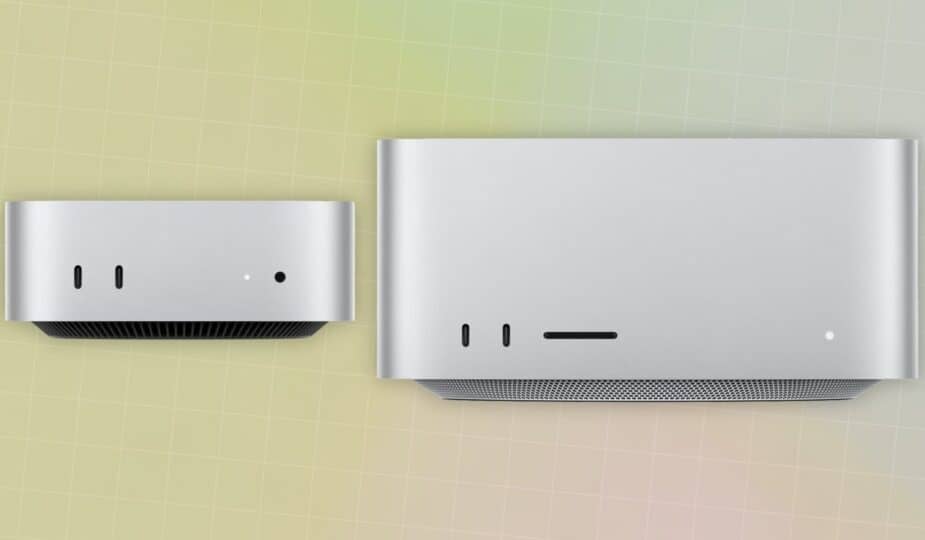M4 Pro Mac mini [left], M1 Max Mac Studio [right]
 12 Facebook x.com Reddit
12 Facebook x.com Reddit
Last updated 5 minutes ago
Original Mac Studio Still delivers powerful performance, but the comparatively inexpensive M4 Pro Mac mini offers a better deal. Here's what you can get for $1,200 in either Mac variant.
Introduced in March 2022, the Mac Studio promised powerful performance in a compact package. Essentially a Mac mini on steroids, the Mac Studio aimed for powerful performance while still sticking to the concept of a small block of computing power.
Generations of Apple Silicon chips have flown by, and the latest Mac models feature the M4 chip. It may be three generations apart, but the original Mac Studio still delivers value to consumers.
You can still buy an M1 Max Mac Studio for around $1,400 if you know where to look.
A new Mac buyer looking for a Mac Studio could potentially find the latest Mac mini a better buy. Especially if they invest a similar amount of money in a configuration.
Here's how the base M1 Max Mac Studio compares to the current $1,399 M4 Pro Mac mini.
M4 Pro Mac mini vs. M1 Max Mac Studio Specs
| Specs | M4 Pro Mac mini (2024) | M1 Max Mac Studio (2022) |
|---|---|---|
| Starting Price | $1,399 Best M4 Mac mini Prices |
$1,999 |
| Dimensions (inches) | 5.0 x 5.0 x 2.0 | 7.7 x 7.7 x 3.7 |
| Weight (lbs) | 1.6 | 5.9 |
| Processor | Apple M4 Pro 12-core CPU, Apple M4 Pro 14-core CPU |
Apple M1 Max 10-core CPU |
| Graphics | 16-core GPU, 20-core GPU |
24-core GPU, 32-core GPU |
| RAM | 24GB, 48GB, 64GB |
32GB, 64GB |
| Network | 802.11ax Wi-Fi 6E wireless network compatible with IEEE 802.11a/b/g/n/ac, Bluetooth 5.3, Gigabit Ethernet, upgradable to 10Gbps |
802.11ax Wi-Fi 6 wireless network compatible with IEEE 802.11a/b/g/n/ac, Bluetooth 5.0, 10 Gbps |
| Storage | 512GB, 1TB, 2TB, 4TB, 8TB |
512GB, 1TB, 2TB, 4TB, 8TB |
| Display Support | Maximum of 3: Three 6K 60Hz via Thunderbolt or HDMI, or one 6K 60Hz via Thunderbolt and one 8K 60Hz or 4K 240Hz via Thunderbolt or HDMI |
Maximum 5: Four Pro Display XDRs and one 4K |
| Ports | HDMI, Three Thunderbolt 5, Two USB 3 Type-C (front) Gigabit Ethernet, 3.5mm Headphone Jack (Front) |
HDMI, Four Thunderbolt 4, Two USB-A, Two USB 3 Type-C (Front) Gigabit Ethernet, SDXC (Front) 3.5mm Headphone Jack |
M4 Pro Mac mini vs M1 Max Mac Studio – Design, Weight, Size
When the Mac Studio was introduced, it was billed as a much taller Mac mini. In many ways, that was true, but that's no longer the case.
For starters, it uses the same rounded, square 7.7-by-7.7-inch chassis that the Mac mini was famous for. Except it's more than twice as tall, at 3.7 inches.
It's still made of aluminum, though the overall package size is 5.9 pounds.
Around back, Apple has, as usual, included a good selection of ports. On the front, Apple has included two more ports: the M1 Max has a pair of USB 3 Type-C ports, while the Ultra once again uses Thunderbolt 4.
The SDXC card slot on the front also makes it useful for videographers and photographers.
M4 Pro Mac mini vs M1 Max Mac Studio: The front of the new Mac miniM4 Mac mini vs M1 Max Mac Studio: The front of the new Mac mini
The Mac mini has been given a major refresh to launch the M4 and M4 Pro. Its redesign includes a much smaller chassis with a footprint of five square inches and a height of two inches.
This makes it less flat and squat than before, comparable to a tiny Mac Studio.
Adding to the comparison are the extra ports on the front of the Mac mini, which borrow an idea from the Mac Studio. These ports are USB-C, supporting USB 3 speeds, meaning up to 10Gbps.
Another big difference is the massive amount of venting on the back of the Mac Studio. It's a tall case, so it made sense to take advantage of the less visible space.
There is no such vent on the back of the Mac mini, as it is too small and cluttered with ports. The vent is on the base, as usual.
There is one other unusual change for the Mac mini: the power button is now on the base of the device. While this means you have to lift the Mac mini to turn it on, you can still reach around the back to turn on the Mac Studio.
Obviously, there will be a big difference in weight. The Mac Studio weighs 5.9 pounds, while the M4 Pro Mac mini weighs only 1.6 pounds.
Mac mini M4
Adorama Coupon
Save up to $50, plus $20 off AppleCare, with promo code APINSIDER at Adorama..
Buy on Amazon Buy on Best Buy
M4 Pro Mac mini vs M1 Max Mac Studio – Processing
As the name suggests, the M1 Max Mac Studio is powered by the M1 Max chip. It consists of a 10-core CPU, using eight performance cores and two efficiency cores.
It was paired with a 24-core GPU, though it could be configured to 32 cores if you wanted. A 16-core Neural Engine, a staple of Apple Silicon, was also on board.
The Media Engine was a big draw for video makers, as it offered hardware-accelerated playback of H.264, HEVC, ProRes, and ProRes RAW. It had one video decode engine, two video encode engines, and a pair of ProRes encode and decode engines.
The M4 Pro starts with a 12-core CPU with eight performance cores and four efficiency cores. That's already a better combo than the M1 Max, but you can also get a 14-core version with two extra performance cores.
The Neural Engine and Media Engine also return, and Apple boasts triple the performance for Apple Intelligence processing.
The low-core CPU has a 16-core GPU, but the upgraded version offers a 20-core GPU.
M4 Pro Mac mini vs. M1 Max Mac Studio: Introducing the M4 Pro Chip
In terms of memory, Apple started the Mac Studio with 32GB of unified memory, upgradable to 64GB at the time of purchase. Memory bandwidth was also high at 400GB/s.
The M4 Pro starts with 24GB of unified memory, upgradable to 48GB and 64GB, matching the upper limit of the M1 Max Mac Studio. Memory bandwidth of 273GB/s isn’t as high as the M1 Max, but it’s still an admirable effort.
In terms of how many screens you can use, the M1 Max Mac Studio can handle five screens at once. This includes four Pro Display XDR 6K at 60Hz using USB-C and one 4K at 60Hz via HDMI.
The M4 Pro Mac Mini can handle three 6K at 60Hz screens via Thunderbolt and HDMI. Alternatively, for a dual-screen setup, it can handle one 6K at 60Hz screen via Thunderbolt, as well as one 8K at 60Hz or 4K at 240Hz screen via Thunderbolt or HDMI.
M4 Pro Mac mini vs. M1 Max Mac Studio – Benchmarks
Since the M4 Mac was released to the public, the new models have been benchmarked, allowing us to compare performance.
Geekbench listings for the 14-core M4 Pro show a single-core score of 3,926 and a multi-core score of 22,698. For the 12-core version, those numbers are 3,905 and 19,929, respectively.
M4 Mac mini vs M1 Max Mac Studio: Single-Core and Multi-Core Results
This is to be expected, since they use similar cores, but the 14-core version has more of them.
The M1 Max Mac Studio only has a 10-core processor, which Geekbench reported as scoring 2,419 in the single-core test and 12,630 in the multi-core test.
We can explain this by a combination of factors. For starters, Apple uses its fastest clocked cores in the M4, and then there’s the number of cores in the multi-core test.
As for graphics, it’s an oddly closer match.
Geekbench results for the M4 Pro’s Metal tests were around 112,800 for the 20-core GPU and over 97,000 for the 16-core one. By comparison, Geekbench gives the M1 Max Mac Studio a Metal score of 105,044.
M4 Mac mini vs. M1 Max Mac Studio: Metal Score
This puts the lower-core M4 Pro on par with the M1 Max, while the higher-core model is significantly ahead.
The problem here is that we rely on the latest Mac Studio benchmarks in the Geekbench results browser. Unfortunately, the results don’t indicate whether it uses a 24-core or 32-core GPU configuration for the test result displayed.
In the worst case, if the 24-core GPU score is used, you could potentially see the 32-core get a better score. Perhaps a third higher, up to about 130,000 under hypothetical ideal conditions, based on the difference in core count.
When it comes to graphics performance, the Mac Studio can still compete with the M4 Pro Mac mini. But not when it comes to CPU performance.
M4 Pro Mac mini vs. M1 Max Mac Studio – Storage, Connectivity, Audio
The Mac Studio with the M1 Max starts with a 512GB SSD, with configuration options up to 8GB. The Mac mini follows the same path with storage options.
For connectivity, the Mac Studio has four Thunderbolt 4 ports, including four Thunderbolt 4 connections, a pair of USB 3 Type-A ports, HDMI, and a 3.5mm headphone jack. Since it was intended to be used in professional environments, it also came with 10Gbps Ethernet as standard.
At the front, the M1 Max has an SDXC card slot and two USB 3 Type-C ports. The M1 Ultra version instead offers two Thunderbolt 4 ports.
M4 Pro Mac mini vs. M1 Max Mac Studio: Rear Ports on the M4 Pro Mac mini
The M4 Pro Mac mini has three Thunderbolt 5 ports on the back, offering twice the bandwidth of Thunderbolt 4 if you have accessories to use it. There's also HDMI and Gigabit Ethernet on the back, with the latter upgradable to 10Gb.
On the front are two USB 3 Type-C ports. There’s no memory card slot on the front, however, but there is a headphone jack.
For wireless connectivity, Apple includes Wi-Fi 6, as well as Bluetooth 5.0 for accessories in the Mac Studio. The M4 Pro supports Wi-Fi 6E and Bluetooth 5.3.
As for audio, both models have a headphone jack with support for high-impedance headphones. There’s also support for HDMI multi-channel audio, so you can output audio through a monitor.
Each model has a built-in speaker that can be used in a pinch, but external options are always better.
M4 Pro Mac mini vs. M1 Max Mac Studio Pricing
The base M1 Max Mac Studio with a 24-core GPU, 32GB of unified memory, and 512GB of storage cost consumers $1,999 at launch. A savvy shopper can get the same configuration for around $1,400 if they look in the right places.
M4 Pro Mac mini vs. M1 Max Mac Studio: Mac Studio on the desk
The M4 Pro Mac mini starts at $1,399 and includes a 12-core processor, 16-core GPU, 24GB of combined memory, and 512GB of storage.
Upgrading to a 14-core processor and 20-core GPU costs $200. Upgrading the memory costs $400 to get 48GB, and another $200 to get 64GB.
Storage upgrades from 512GB start at $200 for 1TB, another $400 for 2TB, another $600 for 4TB, and another $1,200 for 8TB.
Upgrading from Gigabit Ethernet to 10-Gigabit Ethernet costs $100.
M4 Pro Mac mini vs. M1 Max Mac Studio – Tiny and Mighty
The introduction of the Mac Studio offered consumers the best of both worlds. They could get the massive performance that was available in the Mac Pro, but in a form factor very close to the Mac mini.
With the introduction of the M4 Pro Mac mini, it is now possible to get the performance of the M1 Max Mac Studio in an even smaller package.
Of course, there are some compromises, such as a slightly smaller selection of ports due to physical limitations. But something like this can be easily dealt with using the Thunderbolt Dock.
Once again, Apple delivers the performance of a larger product in a much smaller format. In fact, this is its smallest Mac ever made.
For M1 Max Mac Studio owners, the M4 Pro Mac mini delivers a significant boost in CPU performance without losing too much. On the graphics side, things are much simpler: the Mac mini is certainly on par with the M1 Max with its higher number of GPU cores.
For those still considering the M1 Max Mac Studio due to its lackluster performance, the M4 Pro in the Mac mini should make them reconsider.
Where to buy the Mac mini M4 Pro vs Mac Studio M1 Max
The 2024 M4 Mac mini is available from Apple resellers, and Adorama is offering up to $50 off the new models with the promo code APINSIDER. The code APINSIDER also gets $20 off three years of AppleCare for the new Mac mini. You can find a breakdown of the deals in our M4 Mac mini Price Guide.
Meanwhile, the M1 Max Mac Studio is available on eBay — many units are in brand-new condition.
Update November 14, 2024, 9:30 a.m. ET Updated with new charts and updated text to reflect actual testing.
Follow AppleInsider on Google News










